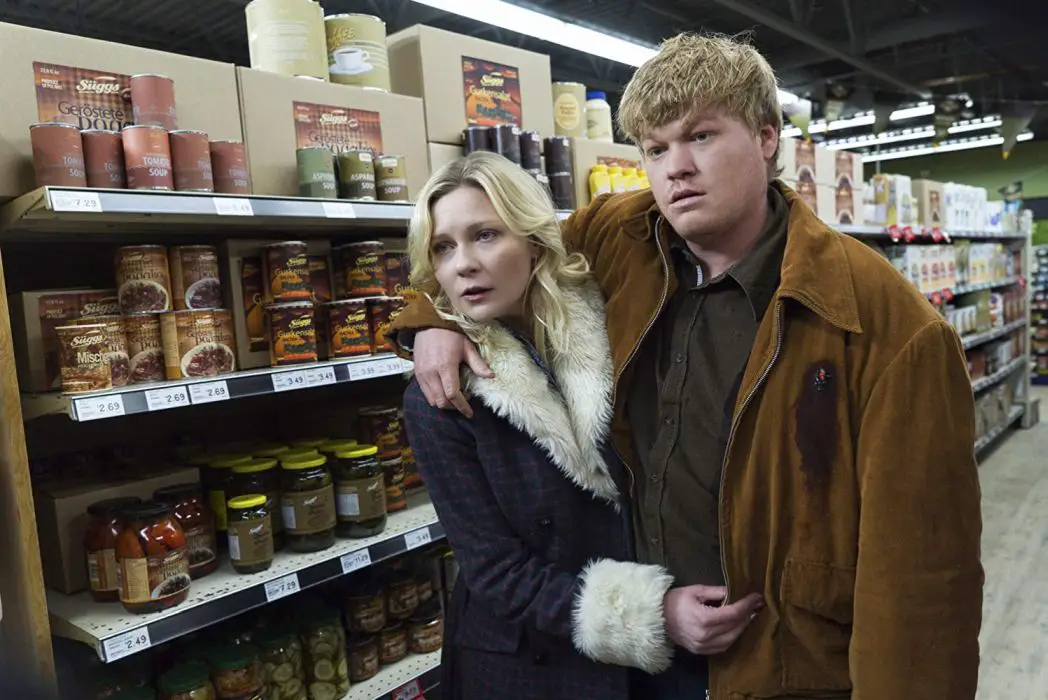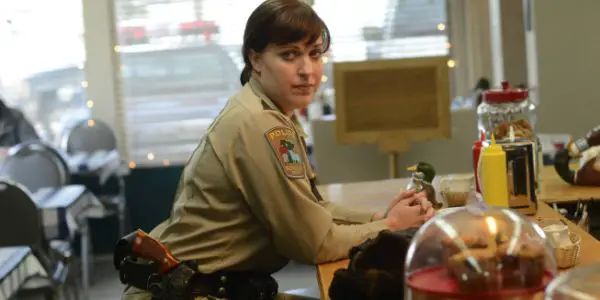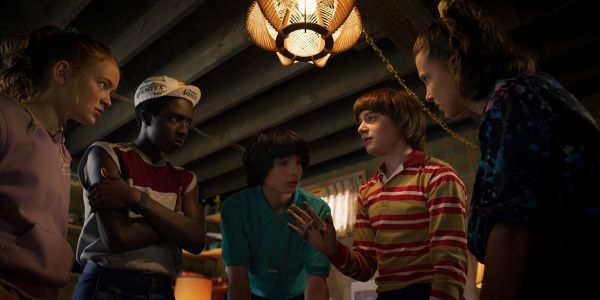How FARGO Succeeded Where STRANGER THINGS Failed

Growing up in the Seattle area, Dana spent her childhood…
When FX announced that they were moving forward with a television adaptation of the 1996 Coen Brothers classic Fargo, there was, understandably, trepidation upon the news. Considered to be not only Joel and Ethan Coen’s best film, but also one of cinema’s best, a television adaptation sounded asinine, especially given the fact that they weren’t creatively involved with the series.
Although they had an executive producer credit, the season would be created and solely written by showrunner Noah Hawley, whose previous works never went beyond one season. This wasn’t even the first time a TV adaptation of Fargo was made. A pilot was shot, starring Edie Falco (yes, really) as Marge Gunderson, directed by Kathy Bates (you read that right), and was intended as a follow-up to the events of the original film. No further episodes were made besides the pilot.
So, everyone was awaiting the release of the series with bated breath. Would it be a poor rendition of the classic film? Would it try (and most likely fail) to imitate the unique voices of Joel and Ethan Coen? Most of all, would it prove that its existence was necessary, that it was something beyond a cash grab of our nostalgia for that dark comedy?
Somehow, Fargo became a thing of its own.
Starring Martin Freeman, Allison Tolman, and Billy Bob Thornton, the series premiered in April of 2014 to wide acclaim for its writing, acting, and directing. It managed what we all thought impossible: it became its own, distinct thing. The series went on to adopt an anthology format, with each season having its own (semi) standalone story but were all set in the same world. Sometimes, characters from past seasons would appear in surprising (but often small) roles.

With season 2 onward, the series became a pastiche of various works from the Coen Brothers, ranging from Barton Fink and The Big Lebowski to No Country for Old Men and Raising Arizona. The series would include shots reminiscent of their most beloved films and would include characters that bared a striking resemblance to others created by that iconic director duo.
Normally when a work would blatantly reframe shots of other famous works, we would look at it as (rightfully) a, well, not pathetic, but let’s say overly loving recreation of something, which is more often than not, better. When the saying “imitation is the sincerest form of flattery” is uttered concerning a work of art, it’s meant as a kind of detraction. But with Fargo, Noah Hawley managed to recreate these shots or character personalities while having them come with their own beauty and meaning.
The final shot of Barton Fink, with a woman sitting at the beach looking on to the sea, is one of their most beautiful, profound shots. This shot is done again in “The Law of Non-Contradiction” by director John Cameron, and when we see it, sure we immediately recognize what it’s referring to. But after the events of the episode, as well as the themes recurrent throughout that third episode (as well as the rest of the season), we walk away with a meaning of its own after we’re given this shot. The episode itself bears several references to Barton Fink, from the setting to the events depicted in the episode. But still, miraculously, Fargo creates its a new meaning from this recreation.
The series, which has now aired three seasons in its entirety with a fourth on the way, creates its own world, its own set of rules and beliefs, from the oeuvre of the Coen Brothers. Fargo, then, is the gold standard of pastiches: it’s creates something new, something beautiful, from a mashup of other great works. It accomplished what is often failed. It became something more than a tribute to one of our greatest filmmakers: it became its own thing.
Now, there is another series that recently released its third season, a series that is one of the most popular shows airing today, a series that is itself a pastiche, a collection, of other famous, beloved works that we all know and love. And it’s a show that, as of its third season, has never become anything more than a cache of references and Easter Eggs: that show is Netflix’s Stranger Things.
Stranger Things was a smash hit upon release. And it couldn’t have come at a more perfect time.
It’s interesting how they both arrived in different ways yet bare several similarities. While Fargo was awaited with fear and immense skepticism, Stranger Things was itself a sleeper hit. It wasn’t an eagerly awaited arrival, far from it. It was a surprise smash hit.

Premiered on July 15th, 2016, the first season was praised for its stellar casting, well-drawn characters, standout performances from Winona Ryder and Millie Bobby Brown, visuals, and strong chemistry between its cast of child actors. Stranger Things was seen by many to be a well-made pastiche of 1980s pop culture, from the written works of Stephen King to the films of Steven Spielberg, John Carpenter, and other much-loved films.
The time it was released couldn’t be better: franchises from that decade were gaining a resurgence, seen in the revival of the widely known Star Wars and the immense popularity of the novel Ready Player One (which itself would gain a film adaptation). The demographic that grew up with 80s’ films, shows, comics, and so on would now be in their late 20s to mid-30s, and generations born well after that decade are themselves becoming enamored by various American works released in the 1980s.
What was once seen to be “nerdy” or belonging to non-mainstream circles are now, well, mainstream. Stranger Things was a massive success, and it still is.
Stranger Things is a mashup, yes, but what does it all add up to?
While we see how various works of music, cinema, television, literature, and even food influence the style and creation of the Netflix series, there is a genuine wonder (at least on my part) on what’s the point of it all. Yes, it’s obvious that these references, allusions, and lifting from countless properties are done because the minds behind the series, the Duffer Brothers, love that decade so much, and that it was formative in how they developed their own writing and directing styles. But, in my mind, there must be a bigger point beyond a 25-episode shrine to Reagan-era America.
Do these countless references create a genuine feeling of their own besides the immediate nostalgia once seen? If I asked myself this right after seeing its first season, I would have said: “Well, no, but with the way it’s done, it doesn’t matter”. Now, after its third (and in my opinion worst) season, all I can think is that there is a hollowness at the center of the Duffer Brothers’ creation: the series is itself an echo of other popular works.
But I must give credit where it is due, the coming-out scene between Maya Hawke’s Robin and Joe Keery’s Steve in the seventh (and penultimate) episode of season 3 was movingly written and acted, although it’s been stated that these two characters were originally intended to become a couple. It was only through the actors that they changed this original decision.
A while after finishing the third season, I thought about the third season of FX’s Fargo. The season, which I believe may very well be its finest, was set in a world seemingly ruled by chaos and happenstance. The season was set in 2010, and we can see why. Now in the aftermath of the 2008 housing crises, which plunged the U.S. into a recession, Americans across the country were rocked financially, yes, but also spiritually.
Much of the 21st century was marked with confusion, disillusionment, and cynicism. Fargo’s third season captured this perfectly.
The 21st century was tumultuous, to say the least. The 9/11 attacks, which shook the core of Americans and shattered their belief that they were safe, as well as the destruction caused by the Bush administration, combined with the worst financial disaster since the Great Recession of the 1930s, made the first 10 years of the new millennium a hard and arduous one. So, it was brilliant, I felt, that the season tried to recapture that almost constant state of being many of us were in during this time.

Coupled with the fact that the season’s villain, V.M. Vargo, played with the perfect mix of charm and vileness by David Thewlis, was a gaslighting, manipulative man who constantly questioned the idea if there really is an objective “truth” (I don’t feel that I need to state how that’s relevant today), the third season was its most profound, disorienting, and chaotic season.
The season alluded and referenced films by the Coen Brothers, specifically films that have a shaggy-dog structure to them; films that by the end makes us ask what the point was to it all. These cribbing of visual and narrative symbolism were done with a reason beyond the fact that they were made by Joel and Ethan Coen. They were made a specific purpose.
The third season of Stranger Things, however, recreated all the worst qualities of 80’s cinema, and, at the same time, some of the worst qualities of 80’s America.
So then, what was the purpose of the ones made in Stranger Things, and to narrow it down, specifically the ones made in season 3? The season trafficked in the worst qualities of Reagan-era films, qualities that were the patriotic, “yeah America!” ones that we (rightfully) look at with disdain. We saw them in the conservative, Red Menace-based films Red Dawn and Rocky IV. These films were solely made to bolster and praise the Reagan administration, conservatives, and continue the fearmongering of the Soviet Union.
And yet, the third season referenced these films in the structure of the season’s overarching narrative, having its antagonists be the stereotypical Russian villains. Their ultimate goal and plan, to construct an elaborate and massive lab underneath the town’s mall, and to harvest the power of the “Upside Down”.

This storytelling decision, to depict the Soviet Union as this big, all-powerful evil nation hellbent on destroying the United States (the fact that the backdrop of all of this is the Fourth of July), was it done to deconstruct conservative films of the 1980s? Was it to question why these films were so loved, and why these films continue to be remembered fondly by Americans? And most of all, was it to show how ridiculous and just plain wrong these films were? No. They were included for one reason and one reason only, because they were (and still are, improbably) beloved 80’s films.
This choice, to me, revealed that the series isn’t anything more than an hour-long spot-the-reference series created to appeal to those who look at that decade with nostalgia and nostalgia alone.
Ultimately, Stranger Things is an ode to a horrific, destructive decade
Thinking about it, I should have seen this from the beginning. For anyone who isn’t a straight, white, cis male, the decade wasn’t amazing, exciting, or something to aspire toward. No, it was a decade where films and television shows refused to acknowledge the existence of so many of us. It was a decade where its beloved administration strived to systematically wipe out queer, trans, black, and brown communities through ignoring the AIDS epidemic and its destructive and racist “war on drugs”. It was a decade where so many Americans were shunned, vilified, and spat upon by the country they inhabit.
And yet, it’s a decade that Stranger Things chooses to look upon with love and admiration. And the third season’s use of Russian stereotypes and its idealistic, one-sided view of the turbulent decade bolsters this fact. This series is nothing but a shrine to a lost decade.
I believe that a show or film can be more than a well-made pastiche or tribute to a specific subgenre of pop culture. I, sincerely I might add, believe that such creations can be used to not only reference these works but create their own meanings from such works. That they can repurpose this art into something real.
Fargo, improbably, thankfully, did this. Stranger Things did not.
Do you agree with this assessment? Do you (most likely) strongly disagree with everything I said? Please yell at me how I’m wrong in the comments!
Does content like this matter to you?
Become a Member and support film journalism. Unlock access to all of Film Inquiry`s great articles. Join a community of like-minded readers who are passionate about cinema - get access to our private members Network, give back to independent filmmakers, and more.
Growing up in the Seattle area, Dana spent her childhood frequenting Hollywood Video and Blockbuster, watching whatever VHS or DVD she could get her hands on. Despite being told that sitting too close to the TV will damage her eyesight, Dana, believing that they didn't know what they were talking about, ignored the advice. Dana has now worn glasses for several years. Her pronouns are she/her.













